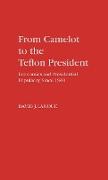- Start
- From Camelot to the Teflon President
From Camelot to the Teflon President
Angebote / Angebote:
This work is a detailed description of the use of Box Jenkins time-series analysis techniques--including autoregressive-integrated moving average (ARIMA) modeling--to test two hypotheses relating economic conditions to presidential popularity...Lanoue's model shows the two hypotheses to be interrelated. Rising inflation rates have a negative effect on presidential popularity, falling inflation rates have no impact. These negative impacts are present only for Democratic administrations. Recession--as measured by declining real disposable income--leads to a decline in presidential popularity. Recovery from recession leads to a return in popularity...Despite the clarity of the writing and the separation of the methodological details from most of the substantive discussions, this work is most appropriate for advanced undergraduates, graduate, and research collections. Annals of the American Academy Presidential popularity has been much discussed in recent years. This analysis deals with questions raised by the differing patterns of public approval experienced by the last six U.S. presidents, starting with John Kennedy's administration (Camelot) and concluding with a look at Ronald Reagan, who has often been termed the Teflon President.
Lanoue begins with an overview of economics and politics as they relate to presidential popularity. He presents the research design and discusses the methodology involved, expecially the use of the Box-Jenkins approach. The results of his analysis are presented in two sections. The first, Inflation and Popularity, presents a model of presidential popularity as it relates to inflation. Specifically, it argues that voters evaluate the economic performances of different parties' presidents in different ways. The second section, Income and Popularity, takes an initial look at symmetry and income, and then presents two approaches to the analysis of asymmetry. This Asymmetric Hypothesis states that the electorate punishes the president and his party for hard times, but fails to reward them when economic conditions improve. The concluding chapter analyzes whether asymmetry is psychological or situational, and considers partisan effects in a chapter subtitled Bad News for Democrats. A final section on macroeconomic policy deals with maximizing popularity through changes in economic priorities.
Folgt in ca. 15 Arbeitstagen
